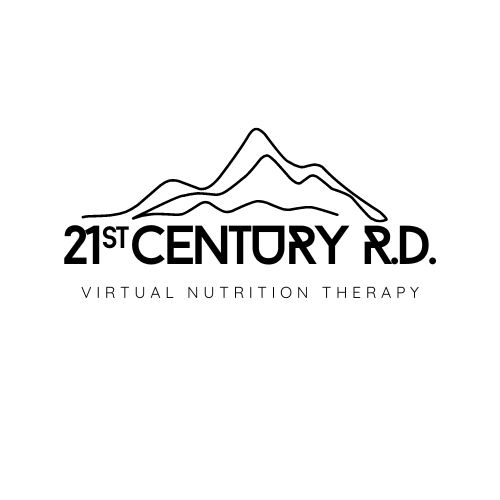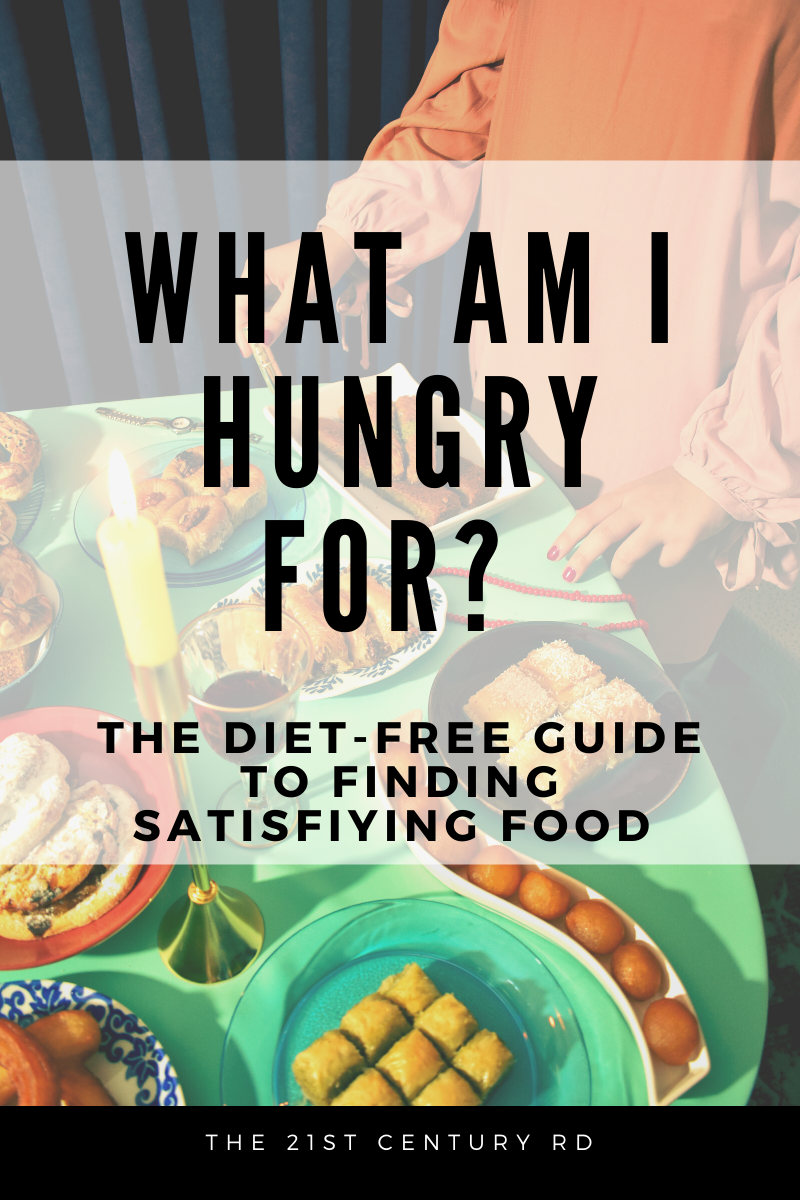What Am I Hungry For?
This guide was inspired by the work of Evelyn Tribole and Elyse Resch from their Intuitive Eating Workbook as well as The Mr. Roe’s Method via TiffanyRoe.com
When we start to let go of the shoulds like “I should get a salad instead of a sandwich, like Mary did”, “I should skip my latte today because I ate too much yesterday”, “I shouldn’t go to the party- since there will be junk food” you might find yourself having no idea what you want to eat.
Those pesky diet-culture-influenced thoughts really can mess with listening to our internal cues surrounding food. This is why rejecting diet culture is listed as the first principle of Intuitive Eating; by no longer being at the mercy of the rude-diet-drill-sergeant in our minds we can tap into what would truly be a satisfying, feel-good, eating experience. Not a stressful, boring, and rigid one.
As you move away from diet culture you may find yourself lost in your fridge or a menu having no idea what to eat. Fear not! This blog can guide you in figuring out exactly what you want to eat (because believe me- you are the expert of your body- including your taste buds!) when you are having a hard time deciding on food.
Included is a helpful visual guide that you can print out and maybe put right on your fridge to come back to when feeling uninspired in the kitchen (oorrrrrr the 21st-century option- save the image to your phone).
I have to recognize it is a privilege, that many of us take lightly, to have ample food available and a variety of options. Please note if you are food insecure, or in an environment without food options, these questions may not be applicable, and getting nourishment in even if it is not exactly what you want is the healthy choice. Not eating, because you are not able to have just what you want, but needing nourishment is a hella slippery slope to disordered eating.
Bottom line: please feed yourself and let it be satisfying as often as possible! For those who have ample grocery money- consider donating to your local food pantry or volunteer your time. If you are experiencing food insecurity- please do not hesitate to reach out for help. Call 1-866-3-HUNGRY.
Okay- let’s dive in!
Review each of the categories and note what stands out to you as pleasant. Every day your body is a little different- so give it your attention rather than getting sucked into a boring routine. Some days might be funky and nothing stands out as overly appetizing, but you might know exactly what you don’t want, which is still helpful information.
A key factor to being able to eat satisfying food is to have a variety of foods available, if you are used to empty cabinets and a fridge with just condiments and a jug of expired milk… grocery shopping may be the first step.
Sometimes one category will feel more important than another for example a hot day might call for something cold but you don’t much care about the texture, or when you are feeling stressed you might want a crunchy texture but don’t much care about the aroma or temperature. You get the idea!
Think Hunger: This guide is ideally used when you are moderately hungry and not ravenous (around a 3-5).
If you find yourself at a level 1-3 hunger ask yourself:
Do I want a substantial snack that will give me some immediate relief and then figure out what I want?
OR
Do I go ahead and eat something that I have on hand (hopefully that is satisfying) because I am too hungry to go through these questions?
Neither answer is right or wrong! Typically getting to that level of hunger is uncomfortable and the eating experience is not very pleasant. We tend to eat really fast and don’t really enjoy the food as much, even if it is tasty. It is also more common to go from a ravenous state to an uncomfortable level of fullness- because we are less tuned in to the eating experience. Pay attention to how this state feels to you. What is it like before you start eating? While you are eating? Once you are done? How could you help to avoid getting to this level of hunger in the future?
If you are moderately hungry ready to figure out what will hit the spot- go to the next category.
Think Taste: Sweet, Savory, Salty, Rich, Bitter, Tart, Spicy, Mild, Smoky, Sour
Examples:
Sweet: fruit, cookies, yogurt, sweet potato, candy
Savory: French fries, meat, chili, quiche, grilled cheese
Bland: cottage cheese, bread, rice, scrambled eggs
Salty: chips, spaghetti sauce, nuts, pickles
Think Texture: Soft, Crunchy, Smooth, Creamy, Chewy, Crispy, Dry, Moist, Flaky, Mushy, Light, Heavy
Examples:
Smooth: applesauce, mashed potatoes, pudding
Crunchy: quesadilla, carrots, popcorn
Chewy: pizza, candy, bagels
Think Temperature: Cold, Hot, Room Temperature- or anywhere in between
Cold: smoothie, orange juice, salad
Hot: soup, lasagna, burger
Neutral: crackers, pbj, banana
Think Aroma: Do any of the following smells sound appealing?
Examples:
Sweet: vanilla, honey, cinnamon
Savory: butter, garlic
Fresh: cucumber, apple, lemon
Smoky-spicy: sausage, curry, BBQ
Earthy: mushrooms, beets, bell peppers
Think Appearance:
Do certain colors stick out to you?
Do you want something in a bowl, plate, or mug?
Do you want something large or something small?
Optional Category- Consider Balance: When choosing what food, you want to eat the most important factors are #1 Having the ability to get/make the food #2 Eating something that will be satisfying to you and provide comfortable fullness. This third factor is applying the 10th principle of Intuitive Eating- using gentle nutrition.
This principle comes last because if it is applied too quickly in one’s journey in trusting their internal wisdom for eating, it can be twisted into diet/wellness culture. Please skip this section if you are still working through ditching diet culture, honoring hunger/fullness, and seeking satisfaction.
Eventually in this journey, you may want to explore this idea of “balancing your food” which can mean something different to everyone. Think about what can be added in to provide different nutrients- like protein, carbohydrates, fats, and fiber. By consuming a variety of macronutrients, you are likely to experience longer “staying power” of food, meaning it can keep you comfortably full longer and feel more satisfying.
Health conditions can be factored in at this stage. For example, a person with diabetes may want to include protein with their carbohydrate intake to help stabilize their blood sugars. Someone that experiences acid-reflux may want buffalo wings and a margarita, but happily settles on BBQ wings and a beer because then it won't feel like a hole is forming in their esophagus.
Remember- this is an optional step literally forever- there is no moral obligation to pursue health.
Other examples of considering balance would be:
Time constraints- will not be able to eat for a longer than normal time.
Recognizing a lack of certain nutrients- and including them in a satisfying manner.
Avoiding certain foods that cause GI distress and using alternatives- like celiac disease and choosing gluten-free bread.
Diet Culture Check: Is my choice being influenced by those (or the lack of those) around me? Do I feel like I am making a “good” or “bad” choice? Does this feel like a reactionary choice or a right-here-right-now choice?
If yes- how can I better honor my internal wisdom and turn down the external diet culture noise? What can be added in? Nourish yourself.
Diet culture is all around us and can sometimes sneak back in. No need to panic- it may be an opportunity to do some exploring like a self-check-in. Dieting could have been a coping mechanism for you in the past- so you can accidentally gravitate back down that path- maybe journal and or book an appointment with your Intuitive Eating provider.
If no- woohoo!!! Enjoy they heck out of that food.
Final Thoughts
You will not always be able to get the exact food that you want, this is meant to act as a tool to help you check in with your body and find something that you can enjoy. Sometimes you will only be able to satisfy 1 or 2 of the categories, sometimes you will be able to hit them all. Eating something that doesn’t quite hit the mark, will ALWAYS be the better option than trying to ignore your hunger.
As you use this guide and become more in-tune with your body, you will likely have an easier time figuring out what food you want in the moment. Building that body trust takes time!
What questions do you have? What categories did I miss? I’d love to hear from you! Comment below or send me an email Kelsey@21stcenturyRD.com
Again, here is the link to download the "What am I hungry for?" guide!








